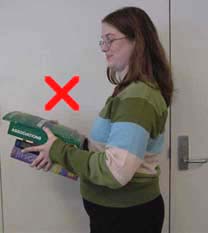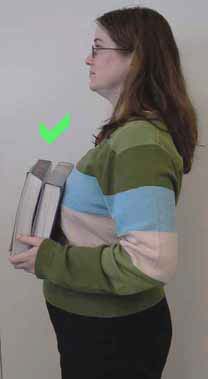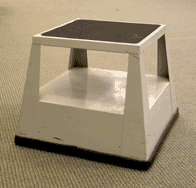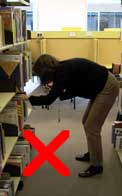

The process of shelving involves:
sorting the books into the correct order on a trolley.
pushing the trolley to the area where they are to be shelved.
carrying the books to the shelves.
shelving the books.
Wherever possible a trolley should be used to move books. When you need to
carry books, carry a comfortable number close to your body.
 |
 |
When bending down to shelve a book on the lower shelves use your legs to position yourself, don’t bend your back.
Use a step stool to reach higher shelves.
Place both feet on the step stool within the surface area.
Step stools should not be lifted, but pushed with your foot.

Reaching above your shoulders could bring books down on top of you. At eye level it’s easy to see and avoid any problems.
Don’t overreach in any direction; move closer to the work.
 |
 |
If you are holding a book and looking for the correct place to shelve it,
support the book on the shelf. This takes away some of the unsupported weight
of the book and takes the pressure off your arms and hands. Don’t try
to force a book between other books if there is not adequate space.
 |
A Shelver can shelve continuously for 2 hours. If he or she is required to shelve for 3 hours they must be given a 10-minute break. The maximum number of hours a shelver can shelve in one day is 4 hours.
Shelving requires a medium level of concentration and a high level of physical activity.
Sort the books on the trolley.
Use a step stool when you need to reach above your shoulders.
Only lift and carry a comfortable number of books.
Hold loads in close to your body.
Don’t bend your back; use your legs.
Rest the book on the shelf while looking for its position.
Don’t try to move the whole shelf of books in one push to make space for an item.
Ensure you don’t shelve any longer than the recommended times.
Wear shoes that protect your feet.
Reduce manual handling where possible.